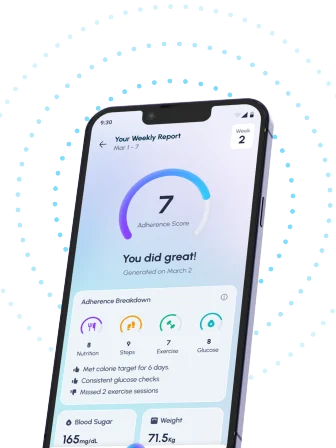Are you wondering, “What is a gluten-free diet plan?” If so, you’re not alone! Over the past few years, gluten-free diets have become increasingly popular, and many people are choosing to eliminate gluten from their daily meals. Whether you have celiac disease, gluten sensitivity, or simply want to try something new, understanding what a gluten-free diet plan is and how to follow it is essential for success.
In this blog post, we’ll break down everything you need to know about a gluten-free diet, including what it is, its benefits, how to start a gluten-free meal plan, and how to make it work for your lifestyle.
What is Gluten?
Before we dive into the gluten-free diet plan, let’s first understand what gluten is.
Gluten is a group of proteins found in wheat and other grains like barley, rye, and oats (unless they are certified gluten-free). It gives dough its elasticity and helps it rise and maintain its shape. Gluten is commonly found in many foods, including bread, pasta, cereals, and even some processed foods, sauces, and snacks.
For most people, gluten is harmless. However, for individuals with certain health conditions, gluten can cause serious health issues.
Why Do Some People Need a Gluten-Free Diet?
There are a few key reasons why people choose to follow a gluten-free diet plan:
- Celiac Disease: Celiac disease is an autoimmune disorder where ingesting gluten triggers an immune response that damages the small intestine lining. This can lead to nutrient malabsorption and a range of digestive and non-digestive symptoms. The only effective treatment for celiac disease is a lifelong gluten-free diet.
- Non-Celiac Gluten Sensitivity: Some people experience symptoms similar to those of celiac disease (like stomach pain, bloating, and fatigue) after consuming gluten, but they do not test positive for celiac disease. This condition is known as non-celiac gluten sensitivity, and the best treatment is also avoiding gluten.
- Wheat Allergy: A wheat allergy is different from celiac disease or gluten sensitivity. It involves an allergic reaction to proteins in wheat, including gluten. People with a wheat allergy need to avoid wheat-containing foods, but they may not need to avoid gluten from other grains.
- Health and Wellness: Some people choose a gluten-free diet for general health reasons. There is ongoing research into whether a gluten-free diet can help with weight loss, improved digestion, or mental clarity, although the evidence is not as strong for these benefits compared to its necessity for people with celiac disease or gluten sensitivity.
What Does a Gluten-Free Diet Plan Look Like?
A gluten-free diet plan eliminates all foods that contain gluten. This includes avoiding traditional bread, pasta, cakes, cookies, and many processed foods that contain gluten as an additive or thickener. While it might sound restrictive at first, there are plenty of delicious, gluten-free foods available.
Gluten-Free Foods
Here’s a list of naturally gluten-free foods you can enjoy:
- Fruits and vegetables: All fresh fruits and vegetables are gluten-free.
- Meats and fish: Fresh, unprocessed meats and fish are gluten-free. However, avoid breaded or battered options, as they may contain gluten.
- Grains and starches: There are many gluten-free grains like rice, quinoa, corn, and gluten-free oats. Make sure the oats are certified gluten-free, as they are often processed in facilities that handle wheat.
- Legumes and nuts: Beans, lentils, peas, and most nuts are naturally gluten-free.
- Dairy: Most dairy products like milk, cheese, and yogurt are gluten-free, but check the labels for any added ingredients.
- Gluten-Free Flours: Almond flour, coconut flour, rice flour, and tapioca flour are popular gluten-free alternatives for baking.
Foods to Avoid on a Gluten-Free Diet
To follow a gluten-free diet, you must avoid any foods that contain gluten. This includes:
- Wheat: This includes white, whole wheat, durum, spelt, and semolina.
- Barley: Found in malt, malted milk, and beer.
- Rye: Found in rye bread and rye-based cereals.
- Oats: While oats themselves are gluten-free, they are often processed in facilities that also process wheat, which can lead to cross-contamination. Make sure the oats you buy are labeled gluten-free.
Additionally, be mindful of hidden gluten in processed foods like soups, sauces, salad dressings, processed meats, and snack foods. Always read labels carefully.
How to Start a Gluten-Free Diet Plan
Now that you understand what a gluten-free diet plan is and why it’s important for some individuals, let’s explore how to start your own gluten-free journey.
Step 1: Educate Yourself About Gluten-Free Foods
Before you begin, it’s important to learn which foods contain gluten and which do not. Start by reading labels and familiarizing yourself with gluten-free alternatives. As mentioned, many fresh foods like fruits, vegetables, meats, and fish are naturally gluten-free, so filling your diet with whole, unprocessed foods is a good foundation.
Step 2: Create a Gluten-Free Meal Plan
Planning your meals ahead of time can help ensure you’re meeting your nutritional needs while staying within your gluten-free guidelines. A balanced gluten-free meal plan should include a variety of whole foods such as lean proteins, vegetables, fruits, healthy fats, and gluten-free grains.
Here’s a sample one-day meal plan:
- Breakfast: Gluten-free oatmeal topped with fresh berries and chia seeds.
- Lunch: Grilled chicken salad with leafy greens, avocado, and olive oil dressing.
- Snack: Apple slices with almond butter.
- Dinner: Baked salmon with quinoa and steamed broccoli.
By planning your meals, you reduce the chances of making mistakes and give yourself plenty of healthy options.
Step 3: Find Gluten-Free Alternatives
Many products traditionally contain gluten, but today, there are gluten-free versions of most foods, including bread, pasta, crackers, and even pizza crust. These gluten-free alternatives can help ease the transition and make your meals more enjoyable. However, remember that not all gluten-free foods are necessarily healthy—some are highly processed and may be full of added sugars or unhealthy fats. Look for whole-food options whenever possible.
Step 4: Stock Your Kitchen with Gluten-Free Essentials
Having the right ingredients in your kitchen will make sticking to your gluten-free plan much easier. Make sure you have a supply of gluten-free grains (like rice, quinoa, and gluten-free oats), gluten-free flour alternatives (such as almond or coconut flour), and gluten-free snacks on hand. Stock your pantry with gluten-free condiments, nuts, and seeds as well.
Step 5: Stay Motivated and Accountable
Sticking to a gluten-free diet plan can be challenging at times, especially when dining out or attending social gatherings. Surround yourself with supportive friends and family, and don’t be afraid to ask questions when dining out. Many restaurants now offer gluten-free options, and it’s okay to ask about cross-contamination or how food is prepared.
Additionally, tracking your progress through a food diary or using an app can help you stay motivated and identify any potential issues.
Real-Life Scenarios
Scenario 1: Jessica’s Journey with Celiac Disease
Jessica was diagnosed with celiac disease when she was 28 years old. After years of digestive issues and unexplained fatigue, her doctor confirmed that gluten was causing her problems. Jessica started a gluten-free diet immediately. While she initially struggled with finding gluten-free foods and reading labels, she quickly adapted. Now, Jessica enjoys a wide range of gluten-free foods, including gluten-free pasta, quinoa-based salads, and rice bowls. She feels more energized and no longer experiences the digestive issues she once did.
Scenario 2: Mark’s Gluten-Free Lifestyle for Better Health
Mark doesn’t have celiac disease, but he noticed that he felt bloated and tired after eating foods containing gluten. After experimenting with a gluten-free diet, Mark found that eliminating gluten helped him feel less fatigued and more alert. He didn’t experience severe symptoms like those with celiac disease, but he felt significantly better by making gluten-free choices. Now, Mark follows a mostly gluten-free diet for general health and wellness.
Expert Contributions
Dr. Karen Smith, a nutritionist and gluten-free expert, explains:
“A gluten-free diet can be incredibly beneficial for those with celiac disease or gluten sensitivity. However, it’s important to maintain a well-rounded diet and avoid overly processed gluten-free products. The key is to focus on whole foods that are naturally gluten-free and rich in nutrients.”
Dr. Paul Jenkins, a gastroenterologist, adds:
“For individuals with gluten sensitivity, avoiding gluten is critical to prevent discomfort and long-term health issues. It’s important to educate yourself about hidden sources of gluten and to make informed choices when dining out or buying packaged foods.”
Recommendations Grounded in Proven Research and Facts
Research supports the benefits of a gluten-free diet for individuals with celiac disease and gluten sensitivity. For instance, studies have shown that people with celiac disease who strictly follow a gluten-free diet experience improvement in gut health, immune function, and a reduction in inflammation. Celiac Disease Foundation
Additionally, a review published in the Journal of Gastroenterology and Hepatology found that a gluten-free diet led to improvements in gastrointestinal symptoms and overall health for people with gluten sensitivity. NCBI
Factual and Reliable Information
It’s important to know that a gluten-free diet is not inherently healthier for those who do not have a gluten-related condition. People without celiac disease or gluten sensitivity can generally eat gluten without any issues. However, for those who need to avoid gluten for medical reasons, a well-planned gluten-free diet is essential for managing symptoms and improving overall health.
Frequently Asked Questions (FAQ) on what is gluten free diet plan
1. What is the difference between celiac disease and gluten sensitivity?
Celiac disease is an autoimmune disorder where gluten damages the small intestine, while gluten sensitivity causes symptoms like bloating and fatigue without damaging the intestine.
2. Can I eat oats on a gluten-free diet?
Oats themselves are gluten-free, but they can often be contaminated with gluten during processing. Look for certified gluten-free oats.
3. What are the health benefits of a gluten-free diet?
For people with celiac disease or gluten sensitivity, a gluten-free diet can reduce inflammation, improve digestive health, and boost overall well-being.
4. Are all gluten-free foods healthy?
Not all gluten-free foods are healthy. Many gluten-free packaged foods are highly processed and may contain unhealthy ingredients. It’s best to focus on whole, natural foods.




